
Chaitanya Mahaprabhu was a 15th-century Indian saint who is considered to be the combined avatar of Radha and Krishna by his disciples and various scriptures. Chaitanya Mahaprabhu's mode of worshipping Krishna with ecstatic song and dance had a profound effect on Vaishnavism in Bengal. He was also the chief proponent of the Vedantic philosophy of Achintya Bheda Abheda Tattva. Mahaprabhu founded Gaudiya Vaishnavism. He expounded Bhakti yoga and popularized the chanting of the Hare Krishna Maha-mantra. He composed the Shikshashtakam.

Gaudiya Vaishnavism, also known as Chaitanya Vaishnavism, the Bengali, Chaitanya or Gaudiya Sampradaya, Chaitanyaism, and Gaura Dharma.</ref> is a Vaishnava Hindu religious movement inspired by Chaitanya Mahaprabhu (1486–1534) in India. "Gaudiya" refers to the Gaura or Gauḍa region of Bengal, with Vaishnavism meaning "the worship of Vishnu". Specifically, it is part of Krishnaism—Krishna-centric Vaishnavite traditions.

'Gauranga' is another name for Sri Krishna Chaitanya Mahaprabhu, the 16th century Bengali Saint and founder of Gaudiya Vaishnavism.The term Gauranga Mahaprabhu references Lord Chaitanya possessing the golden complexion of Srimati Radharani as an incarnation or avatar of Sri Krishna.यद्दिव्यनाम स्मरतां संसारो गोष्पदायते । सा नव्यभक्तिर्भवति तद्रामपदमाश्रये ।।

Kṛṣṇadāsa Kavirāja Gosvāmī was the author of the Caitanyacaritāmṛta, a biography on the life of the mystic and saint Caitanya Mahāprabhu (1486–1533), who is considered by the Gaudiya Vaishnava school of Hinduism to be an incarnation of Rādhā and Kṛṣṇa combined.
The Chaitanya Charitamrita, composed by Krishnadasa Kaviraja in c. 1557, is written in Bengali with a great number of Sanskrit verses in its devotional, poetic construction, including Shikshashtakam. It is one of the primary biographies detailing the life and teachings of Caitanya Mahāprabhu, the founder of Gaudiya Vaishnavism. The stories of Chaitanya's life are mixed with philosophical conversations detailing the process of Bhakti yoga, with special attention given to congregational chanting of Krishna's names and the Hare Krishna mantra.

Rupa Goswami was a devotional teacher (guru), poet, and philosopher of the Gaudiya Vaishnava tradition. With his brother Sanatana Goswami, he is considered the most senior of the six Goswamis of Vrindavan associated with Caitanya Mahaprabhu, a hidden avatar (incarnation) of Krishna in Kali Yuga.
Vrindavana Dasa Thakura or Brindaban Das (1507–1589) was the author of the Chaitanya Bhagavata, the first full-length biography of Chaitanya Mahaprabhu written in the Bengali language.

Pancha Tattva in the Gaudiya Vaishnava tradition of Hinduism refers specifically to the Five aspects of God or Absolute Truth.
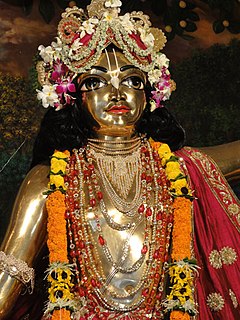
Gadadhara Pandita, also known as Pandita Goswami, was a close associate of Chaitanya Mahaprabhu. Gadadhara Pandita Goswami is described as a handsome young boy, student of Nyaya and ranked highest among the inner circle of Chaitanya Mahaprabhu's followers.

Bhakti Hridaya Bon, also known as Swami Bon, was a disciple of Bhaktisiddhanta Sarasvati and a guru in the Gaudiya Math following the philosophy of the Bhakti marg, specifically of Caitanya Mahaprabhu and Gaudiya Vaishnava theology. At the time of his death, he left behind thousands of Bengali disciples in India.

Madhavendra Puri also known as Madhavendra Puri Goswami is a Vaishnava saint who appeared in the 14th century. He was initiated in to Dvaita Vedanta of Madhvacharya of Udupi region of Karnataka, was highly revered in Chaitanya Mahaprabhu's Gaudiya Vaishnavism

Gaura Purnima is a Vaishnava festival that celebrates the appearance of the Supreme Personality of Godhead Sri Chaitanya Mahaprabhu (1486–1534), who founded Gaudiya Vaishnavism. It occurs on the Purnima in the Hindu month Phalguna, usually falling in March or April.
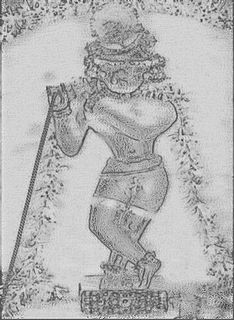
Radha Ramana is a famous image of Radha Krishna worshiped in Hinduism. There is a famous temple of this deity in Vrindavana, Uttar Pradesh, India.
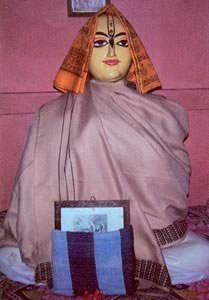
Haridasa Thakur was a prominent Vaishnava saint known for being instrumental in the initial propagation of the Hare Krishna movement. He is considered to be the most famous convert of Chaitanya Mahaprabhu, apart from Rupa Goswami and Sanatana Goswami. His story of integrity and unflinching faith in the face of extreme adversity is told in Chaitanya Charitamrita, Antya lila. It is believed that Chaitanya Mahaprabhu himself designated Haridasa as nāmācarya, meaning the 'teacher of the Name'. Haridasa Thakura, was a devotee of God, Krishna, and had practiced chanting the names of the Lord, Hare Krishna, 300,000 times daily.
Fatehpur, Fatepur, or Phattepur may refer to any of a number of places:
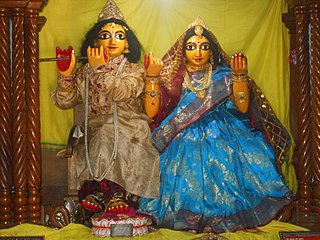
Vishnupriya Devia.k.a.Biṣṇupriẏā Dēbī, was the daughter of Raj Pandit Sanatan Mishra and second wife of Chaitanya Mahaprabhu. She is believed to be the reincarnation of the Goddess Satyabhama, the third consort of Krishna.

The Advaita Parivāra is the succession of disciples descending from Śrī Advaita Ācārya, the joint avatāra of Śrī Sadāśiva and Mahāviṣṇu. It is one of the main branches of the Gauḍīya Vaiṣṇava sampradaya, which started with Śrī Caitanya Mahāprabhu.
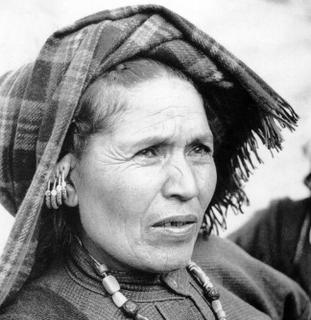
Gaura Devi was a grassroots activist and a rural women community leader from India who played an important role in the Chipko movement.

Shri Haridas Shastri (1918-2013) was an Indian Gaudiya Vaisnava scholar and practitioner. A prolific Sanskrit scholar, he wrote more than a sixty books, including translations from the Sanskrit of several Gauḍīyā books and his own commentaries on them. His original works include the highly regarded book, the Vedānta-darśanam bhāgavata bhāṣyopetam, his translation-cum-commentaries of the Sat Sandarbhas, and his transliterations of Śrī-caitanya-bhāgavata, Śrī-caitanya-caritāmṛta and Śrī-caitanya-maṅgala. Jonathan Edelmann at the University of Florida has called Shastri "arguably the most prolific and well-educated Gauḍīya Vaiṣṇava “insider” scholar of the twentieth century" and "a voice distinct from the more well known Gaudīya-Maṭha and ISKCON". Among his disciples is the noted Gauḍīyā scholar and practitioner, Dr. Satyanarayana Dasa.











